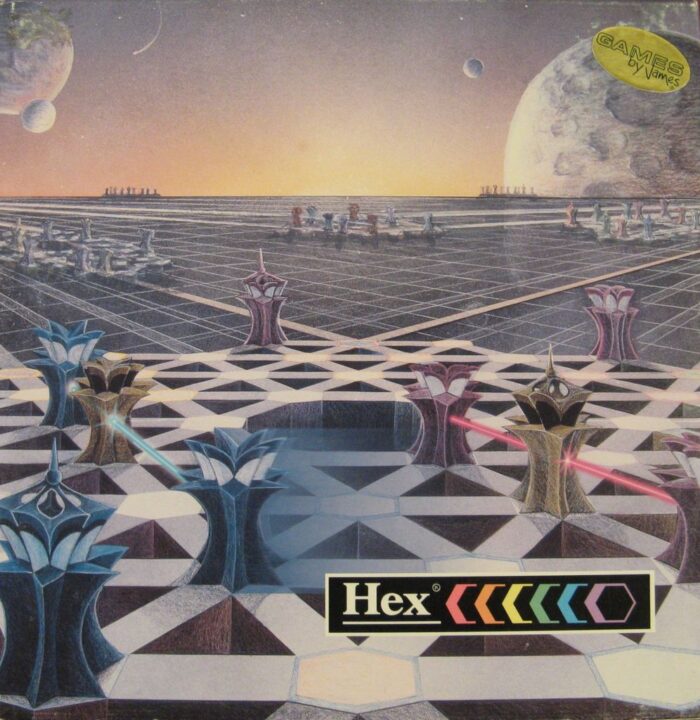Ah, the game of Hex! Welcome to my review, folks. If you’re new here, let me tell you, Hex is a thrilling dance between strategy and wit. Imagine chess, but with less Queen drama and more subtle cunning. In my humble opinion, it’s just the right mix of simplicity and strategic depth.
“`html
How It Plays
Setting Up
First, grab a friend who enjoys strategy more than luck, and a board that looks like a honeycomb. Decide who plays which color. Each player takes their colored pieces. That’s it! You’re all set to start your mind-bending journey.
Gameplay
The aim is simple—connect your sides of the board with a continuous path of your colored pieces. Players take turns placing one piece on any empty hexagon. Seems easy, right? Not so fast! This game is a mind maze. Each move can block your opponent or open a new route for yourself. It’s like playing chess, but without all those confusing horse moves.
Winning the Game
The first player to connect their two opposing sides with a chain of their colored pieces wins. Remember, it’s all about thinking ahead and outmaneuvering your opponent. Win and you get bragging rights for your strategic genius. If you lose, blame it on your opponent’s lucky last move (even if Hex isn’t about luck).
“`
Want to know more? Read our extensive strategy guide for Hex.
Gameplay Mechanics: The Simple Yet Strategic World of Hex
Ah, Hex! The game that’s got me hooked, and it ain’t letting go anytime soon. Imagine a board game where your only opponents are your intellect and your inclination to overthink. That’s Hex for ya! This game’s mechanics are as simple as my Aunt Linda’s recipe for ice cubes, but the depth? Oh boy, it’s deeper than a conspiracy theorist’s YouTube rabbit hole.
In Hex, you play on a diamond-shaped board made up of hexagonal cells. Your goal? Connect one side of the board to the opposite side with an unbroken chain of your colored tiles. Sounds easy? Trust me, it’s like trying to convince my dog to actually fetch the ball back!
Each player gets a color, either red or blue, and takes turns placing their tiles. Unlike my recent attempt to play the kazoo, there’s no randomness here. No dice, no cards—just pure strategy. That’s what I love about Hex. The fairness of this game is like a judge in a beauty pageant for potatoes: everyone’s got a fair chance.
Every move you make forces your opponent’s hand, and there’s no turning back. It’s like chess, but with less frustration and fewer pieces to knock over when you finally lose it. By the end of a session, even my cat starts looking like a valid opponent. Just when I thought I couldn’t handle another game of chance, Hex came along and saved my dignity.
So, you’re geared up and ready to conquer the board? Hold your horses! Next, we’re diving into the world of strategy and tactics that’ll make you the Hex champion of your living room.

Strategizing Your Way to Victory in Hex
Ah, Hex! The game that taught me the true meaning of strategy and the art of thinking several steps ahead. Hex is like a chess match but without that weird pressure to capture a knight and feeling like you’re in medieval times. It’s a beautifully simple game at the surface, but oh boy, does it layer on the strategy like a good lasagna.
Now, Hex’s board looks like a honeycomb on steroids, with each cell crying out to be part of your winning line. The goal? Connect your two sides of the board before your buddy does. Sounds simple enough, right? Wrong! Because once you place that first piece, you’ll feel the panic set in and your mind racing like it’s the last lap in Mario Kart.
The genius of Hex is that it strips away randomness, leaving pure strategy in its place. You’re not relying on a lucky dice roll or pulling a miracle card from a deck. Everything depends on your decisions and how you anticipate your opponent’s moves. You can block your opponent’s path and weave your own, but every time you think you’ve got a handle on things, your friend pulls a sneaky trick that leaves you scratching your head, wondering if you’ve missed your destiny as a chess grandmaster.
My friends and I have spent evenings locked in Hex battles that felt more intense than a final boss fight. Each move was met with groans, laughs, and the occasional cry of “No, anything but that!” So if you’re up for a thrilling test of wits, Hex is your ticket. And just wait till I tell you about how players interact in this little gem.
Player Interaction in Hex: More Than Just a Game
Hex is one of those games that not only helps you bond with friends but also helps you find out which of them have a poker face that would make a professional bluffer proud. Imagine sitting across the table, staring into the eyes of your opponent, trying to decipher their next move. It feels a bit like a staring contest, only with more strategy and fewer tears.
Player interaction in Hex is all about the mind games. Each move you make is a step in the dance of strategic warfare. You lay a piece down and watch your friend’s face like it’s about to reveal the secret to winning the game. But alas, they give you nothing. It’s like trying to read a book with no words.
What makes the interaction in Hex so delightful is the fact that no two games play out the same way. Each game demands a new strategy, fresh moves, and a bit of cunning. If you’re someone who enjoys a game of wits where victory is sweet and defeat is, well, a learning experience, then Hex is your kind of game.
The constant back-and-forth, the subtle psychological warfare, and the “aha!” moments you share with your opponent make every game of Hex an adventure. It’s a place where friendships are tested, alliances are made and broken, and laughter is always part of the package.
But before you get too caught up in the strategy, let’s check out the game’s components quality. Trust me, it’s worth it.
Hex: Do The Components Measure Up?
So there I was, sitting around with my friends, opening up Hex for game night. I know, I know, the name sounds like a magician’s trick gone wrong, but bear with me. The first thing we noticed were those shiny bits and boards staring back at us like treasure hunters finding a hidden stash. The board itself is pretty sleek. It’s like a quilt, but instead of keeping your nan warm, it’s here to challenge your mind.
The pieces are mere disks. Not the chunky kind you’d send rolling across the table when you’re losing your cool. Nope, these are modest, lightweight, and they fit nicely where you need them. It’s simple, really. Almost too simple. You won’t be able to break them if you tried. Trust me, my clumsy buddy Tom managed to drop half the pieces under the couch, and they came out unscathed.
Color-wise, they stick to the basics – black and white. Nothing screams ‘fancy’, but minimalism is trendy anyway, right? Who needs gold-plated game pieces when you’re caught up in a mental wrestling match of wits and cunning?
Let’s chat a bit about the box. It’s sturdy enough that when I saw my cat eyeing it as a bed, I knew it would survive the feline invasion. Just keep an eye on those sneaky felines who have a knack for finding naps in odd places.
Would I recommend Hex? Oh, absolutely. It might not win a beauty contest, but the components do their job. For me, that’s a win. Just don’t let my cat hear that.
Conclusion
And that, folks, concludes our rollercoaster ride with Hex! This game’s got the brains of chess and the heart of strategy. It’s like a juicy brain-teaser that keeps you up at night. While Hex’s simplicity might fool you, it requires a strategic mind and a little spark of creativity. Most importantly, there’s zero luck involved—so don’t blame the dice when you lose! The components might be minimalist, but it’s all about the game here, not the glam. Grab some friends, clear the table, and get ready for a battle of wits. Overall, I give Hex a solid 4 out of 5 stars. Get ready to hex your pals into submission!

